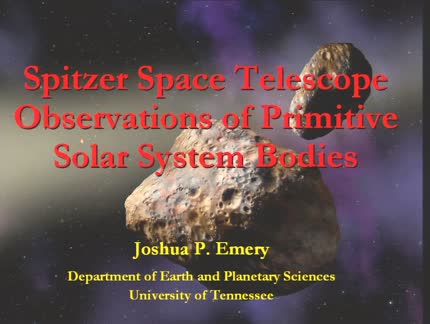Found 2 talks width keyword Kuiper Belt

Abstract
Understanding the composition and the nature of any asteroid approaching the Earth, and consequently potentially hazardous, is a matter of general interest, both scientific and practical. The potentially hazardous asteroid 1999 RQ36 is especially accessible to spacecraft and is the primary target of NASA's OSIRIS-REx sample return mission. Spectra of this asteroid point to the most primitive meteorites (CIs and CMs) as the most likely analogs. Asteroid (3200) Phaethon is also particularly interesting. Together with 2005 UD and 2001 YB5, is one of the only 3 near-Earth asteroids with associated meteor showers, which mostly come from comets. There is evidence of the presence of hydrated minerals on its surface, usually associated with organic material. Both asteroids are classified as "B". B-type asteroids are found mostly in the middle and outer main belt and are believed to be primitive and volatile-rich. We combine dynamical and spectral information to identify the most likely main-belt origin of these two objects.

Abstract
The Infrared Spectrograph (IRS) on Spitzer has observed more than 120 asteroids, several Centaurs and Kuiper Belt objects (KBOs), and satellites of the giant planets. The asteroid sample includes objects from near-Earth space, through the Main Belt, and into the Jupiter Trojan swarms. Asteroids from all taxonomic classes have been observed, as have several binary and multiple component systems. The diameters of these targets range from a few hundred meters to a few hundred kilometers. On the whole, IRS has provided a broad sample of emissivity spectra of small Solar System bodies. The largest emissivity features detected are at the 10% level and are confined to the more primitive asteroid classes. Significant spectral variation is apparent among the IRS asteroid sample. Some of the dust observed in the close environment of other stars likely comes from asteroid collisions, so asteroids in the Solar System are proper mineralogical analogs. As capabilities continue to improve, direct observations of small body populations in other systems and inter-comparisons between systems will foster significant insights into the formation and evolution of planetary systems. The Solar System occupies a unique role by its accessibility and the detail to which it can be studied. While the IRS data are a good start, there is much to be learned from a larger set of mid-infrared spectra (e.g., from JWST and SOFIA). In this talk, I will present an overview of the IRS observations of small Solar System bodies, with a few representative objects highlighted for detailed discussion.« Newer Older »
Upcoming talks
- Runaway O and Be stars found using Gaia DR3, new stellar bow shocks and search for binariesMar Carretero CastrilloTuesday April 30, 2024 - 12:30 GMT+1 (Aula)
- Detecting GWs in the muHz: natural and artificial satellites as GW detectorsProf. Diego BlasThursday May 2, 2024 - 10:30 GMT+1 (Aula)









